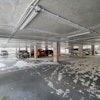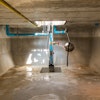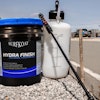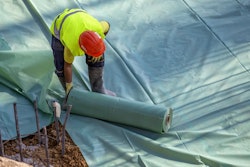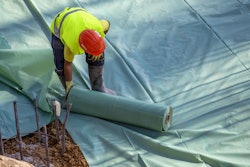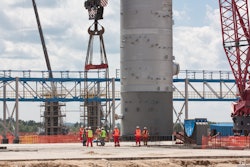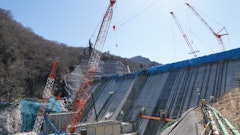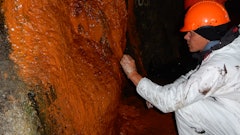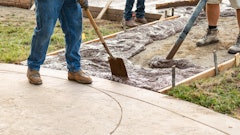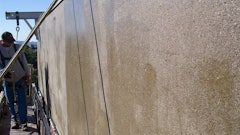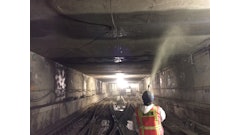
When it comes to vapor intrusion barriers, ease of installation is one of the key elements contributing to a successful project. Recently, a full suite of vapor barriers has been released that employ nitrile-advanced asphalt latex, offering a significant improvement in ease of application and chemical resistance over generic latex-asphalt sprays such as styrene-butadiene (SBR) asphalt latex.
In a composite vapor barrier system, the asphalt latex core is used to seal seams and penetrations (e.g. pipes and electrical conduits) in the base layer. While the base layer provides the bulk of the protection, at the seams and penetrations, the latex core is the primary defense against vapor intrusion.
The previous generation of asphalt latex incorporated rubberized asphalt adopted from the waterproofing industry and repurposed for vapor mitigation. These latexes often contained SBR due to its hydrophobic nature, which made it an excellent water repellant. However, when used for vapor mitigation applications, it was discovered that SBR had a tendency to sorb hydrocarbons and solvents, concentrating them until they broke through the barrier.
On the other hand, nitrile, which is used as a component in chemically resistant rubber gloves, is a far more effective deterrent against vapor intrusion. Replacing the SBR in the latex core with nitrile results in a far more effective, but still easily applicable latex core.
Save Money
The easier a barrier is to apply, the quicker the work can be completed, thus saving money on contractor costs and minimizing any downtime to existing operations. Especially in situations where the installation of a barrier is a voluntary preemptive action, cost is a critical factor. Designed with this in mind, these vapor barriers are shipped as large rolls of chemically resistant flexible sheets that can easily be unfurled to cover large areas and then quickly sealed with a nitrile-advanced asphalt latex. When done correctly, the vapor barriers can be installed 30-40%faster than alternate plastic sheeting or HDPE (high density polyethylene) systems.
Nitrile-advanced asphalt latex is a key component of these novel vapor barrier systems, offering a short curing time, even at cool temperatures, which helps to reduce installation time and impact to construction schedules.
Minimize Mistakes
While barriers should always be installed using certified applicators who follow strict quality control measures, mistakes can happen. The easier a barrier system is to apply, the lower the potential for application complications. If spotted, installation errors can take time to fix, which costs money. Worse yet, installation errors that go unnoticed will diminish the structural integrity of the barrier, reducing its efficacy at fulfilling its intended purpose: Preventing unwanted vapors from entering occupied spaces.
The installation methods for these new vapor barriers is relatively simple, and involves rolling out the base layer (high-tensile strength polyethylene bonded to a geotextile and potentially a metallized film depending on the product selected), sealing the seams with the nitrile-advanced asphalt latex, and then ensuring all penetrations are individually sealed as well. The manufacturer provides detailed instructions and real-time installation support to ensure a smooth installation process. In addition to ease of installation, these barriers offer unparalleled chemical resistance, an industry leading warranty, and the physical toughness to withstand the stresses of a construction site both during and after installation, providing additional safeguards.
After the barrier has been installed, excess nitrile asphalt latex can be cleaned up with warm water and soap as opposed to generic asphalt-latex materials such as SBR asphalt latex, which must be cleaned with diesel fuel which can potentially leak into the sub-slab and cause further contamination issues.
Reduce Liability
With its ease of application and increased chemical resistance, the nitrile latex core plays a large part in preventing vapor intrusion and, consequently, reducing the liability of property owners. When vapors enter an occupied space, it can cause both short-term and long-term health issues, including respiratory issues, migraines, rashes, cancer, and in some cases, death. Even low levels of vapor intrusion are enough to harm human health and impact property values.
Vapor intrusion has led to lawsuits which are both costly and time consuming. In New York, investigations by the Department of Environmental Conservation revealed that the IBM Endicott campus had large plumes of toxic chemicals such as TCE, with vapors that entered the overlying buildings. Over 1,000 plaintiffs sued IBM for $100 million, and after six years of costly litigation, the case was settled for an undisclosed amount.
By making these barriers easy to apply, application errors are minimized making it less likely that vapors can enter a building and reducing the likelihood of vapor intrusion and any associated legal action.
Nitrile-core spray-applied latex is a major upgrade from previous latex cores and represents the next evolution in vapor intrusion mitigation technology. With simple installation procedures and advanced efficacy, this novel suite of vapor intrusion mitigation tools can be applied quickly and effectively, minimizing the time and cost of construction, risk to human health and potential liability.
 Hieu Nguyen, Senior Research Engineer, Land ScienceLand Science, a division of REGENESIS
Hieu Nguyen, Senior Research Engineer, Land ScienceLand Science, a division of REGENESIS

